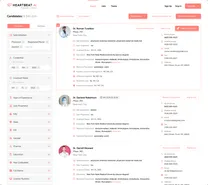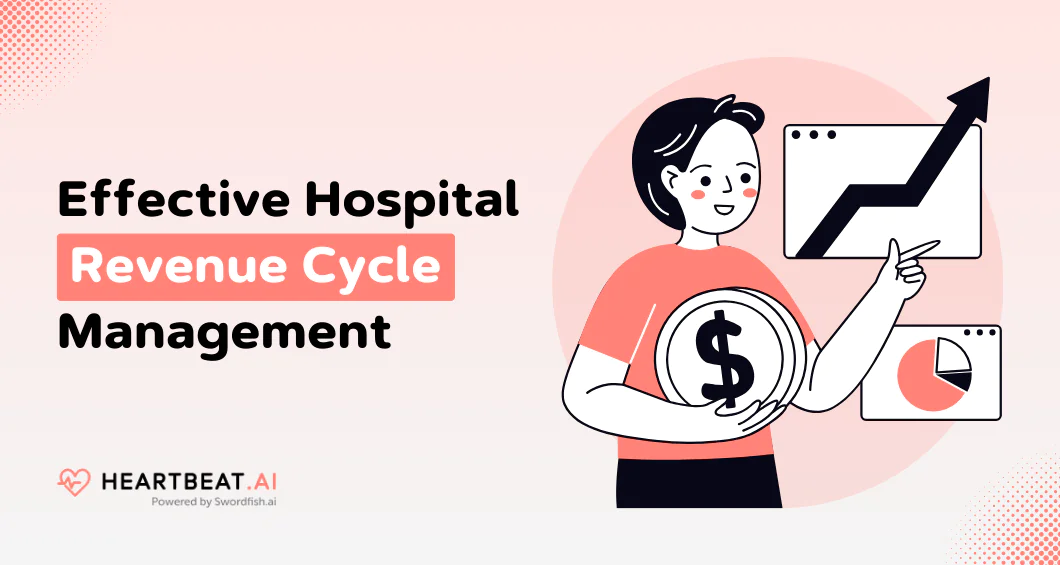
Managing the money in a hospital, a process known as revenue cycle management is extremely important. In essence, it’s the financial journey from when a patient makes an appointment to when they receive their treatment.
This process includes billing patients, dealing with insurance claims, and collecting payments. It’s a complex series of steps where each part is crucial.
Now, if there’s a problem or delay at any stage, the hospital’s finances can be significantly affected. However, if you are an expert at hospital revenue cycle management, it won’t be a big hassle.
This article explains why effective hospital revenue cycle management is vital for maintaining a hospital’s financial health and a strategic guide on revenue cycle management. So, keep on reading.
What’s on this page:
What Is the Revenue Cycle In Healthcare?
The healthcare revenue cycle is all about handling the money side of things in healthcare. It begins when a patient makes an appointment or walks into a hospital.
First, they register and provide their details. Then, the hospital keeps track of all the services and care given to the patient, which is called charge capture.
Next comes billing, where the hospital prepares and sends out the bill for those services. Finally, it’s about collecting payments. The cycle is complete when the hospital or healthcare provider gets fully paid for all the care they provide.
Importance of Effective Hospital Revenue Cycle Management
Revenue Cycle Management, or RCM, is essential for keeping healthcare facilities operating smoothly and ensuring that services are paid for correctly and promptly. Here’s a closer look at why RCM is so important.
Financial Stability
RCM is crucial for a healthcare organization’s financial well-being. The revenue it generates is vital for covering expenses such as salaries, equipment, and more. If RCM is mishandled, the organization risks losing money and facing financial instability.
For example, a study by the Healthcare Financial Management Association pointed out that hospitals could lose an average of $62.75 per claim due to errors and inefficiencies in RCM processes.
Timely Payment to Providers
Making sure healthcare providers get paid on time and the right amount is another important part of managing hospital finances. This is especially critical for providers paid on a per-service basis, as their income directly depends on the volume of services they render.
When claims are not managed properly, it can result in delayed payments, leading to financial strain. According to the Medical Group Management Association, on average, it takes about 31 days for a medical practice to get paid for a claim.
Patient Satisfaction
The role of RCM in patient satisfaction cannot be overstated. Patients expect their billing experience to be straightforward and efficient. If the RCM process leads to confusing or slow billing, it can frustrate patients and make them consider changing their healthcare provider.
The American Medical Association reports that 69% of patients would think about switching providers if the billing process took more than two weeks.
How to Succeed at Healthcare Revenue Cycle Management
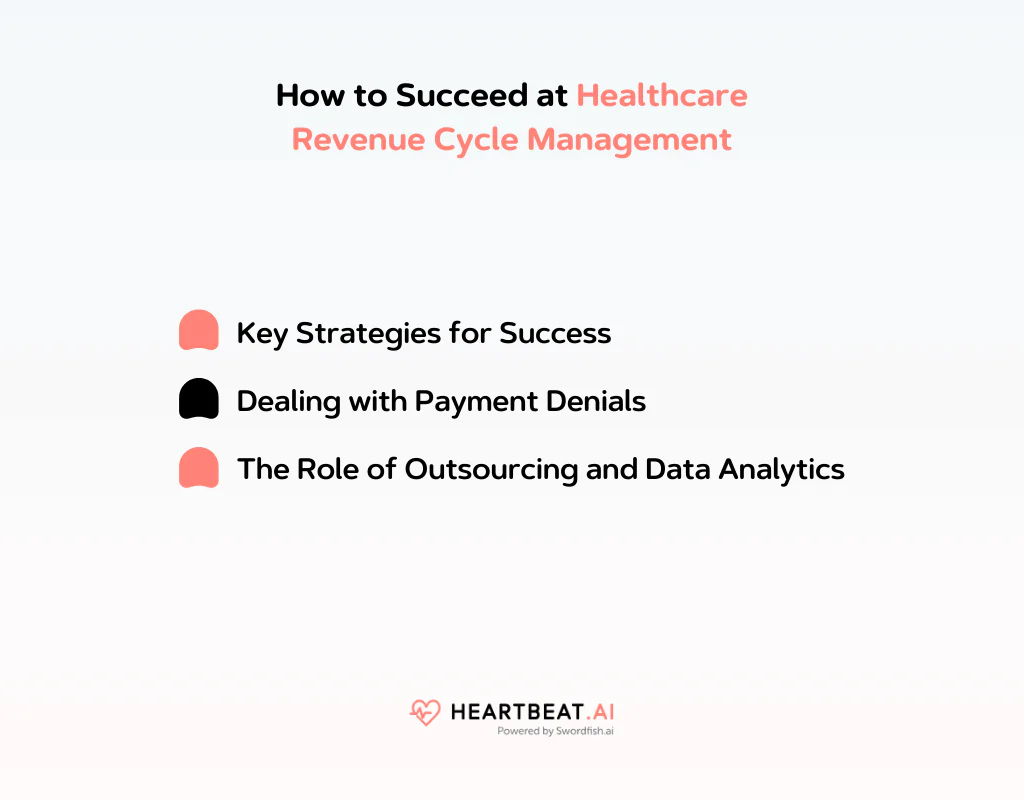
To succeed in RCM, healthcare facilities need to ensure they’re making more money than they’re spending. Also, you’ll have to know the steps of revenue cycle management. There are several ways to improve how they manage their finances and get payments on time.
Key Strategies for Success
First, it’s important for these facilities to focus on the patient experience from the start. The initial steps, like checking if a patient’s insurance will cover their services, are crucial.
Mistakes in this early phase can lead to payment delays. This step is especially vital to avoid issues with insurance companies not covering the costs.
According to a study by Hayes Management, not checking insurance properly, along with other early mistakes, are big reasons why payments for services, particularly for COVID-19 treatments, might not be approved.
To reduce errors, many healthcare providers have started using digital tools. This change was especially helpful during the COVID-19 pandemic.
For example, as Plank noted, digital check-ins allow patients to register without physical contact, making the process safer and more convenient. They can confirm their personal details, upload pictures of their insurance and ID, and sign necessary forms online, whenever they want.
Dealing with Payment Denials
Another big challenge is handling denied claims. Simple errors like incorrect coding or missing a signature can lead to denials. Since 2016, hospitals have seen a 23% increase in denied claims.
To fight this, healthcare organizations are training their staff better, teaching patients about the costs, and using software that helps with coding and checking insurance automatically. They also keep a close eye on claims to quickly figure out and fix any issues.
The Role of Outsourcing and Data Analytics
During the economic troubles caused by the pandemic, some facilities have started outsourcing their financial management. This can help balance their budgets, but it’s not without risks, as some have seen an increase in denied claims.
Many are also turning to data analytics to improve how they manage finances. This technology helps them understand and manage lots of data, set financial goals, and even predict the outcome of claims.
Now, it’s especially helpful that how well a hospital treats its patients and how happy they are matters more than just the services given. This means getting paid depends more on quality and satisfaction.
7 Best Practices for Revenue Cycle Management
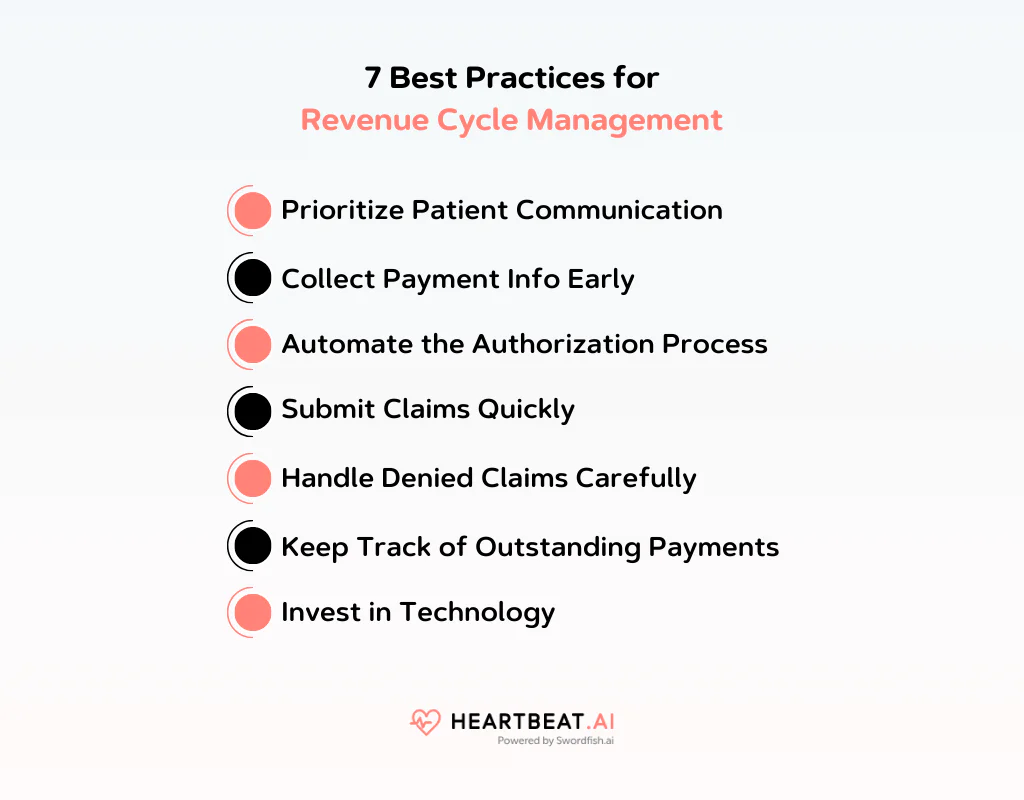
Making sure healthcare providers are paid on time by patients and insurance can be tough because medical billing is complex. Here are some quick tips to simplify the process.
Prioritize Patient Communication
Start by keeping patients in the loop about their payments. A clear and open relationship helps build trust and loyalty. Explain billing clearly and offer different payment options.
This approach can prevent surprises and make patients feel more in control. Since most people, especially younger ones, prefer paying online, offering digital payment options could improve their experience.
Collect Payment Info Early
Instead of waiting until after the appointment, ask for payment details when booking. This can include insurance information or credit card details for services not covered by insurance, making the payment process smoother for both parties.
Automate the Authorization Process
Using automation for verifying insurance claims can save a lot of time. This way, claims are processed faster, and patients know right away if a service is covered.
Submit Claims Quickly
To avoid delays, file insurance claims as soon as a service is provided. This ensures payments are made promptly.
Handle Denied Claims Carefully
Not all claims will be accepted. Common reasons include errors like missing information or incorrect coding. Keeping an eye on denied claims helps identify and fix recurring issues.
Keep Track of Outstanding Payments
Monitor payments owed to you, especially those overdue by more than 45 days. This helps identify if there are issues with your billing process.
Invest in Technology
Handling payments by yourself can be tough. It’s a good idea to use a system that can help with billing and filling out claims, and that can automate some of the work. This way, your team has less paperwork to worry about and can spend more time taking care of patients.
Challenges of Healthcare Revenue Cycle Management
Managing money in healthcare is tricky because the rules keep changing. Here are some of the challenges:
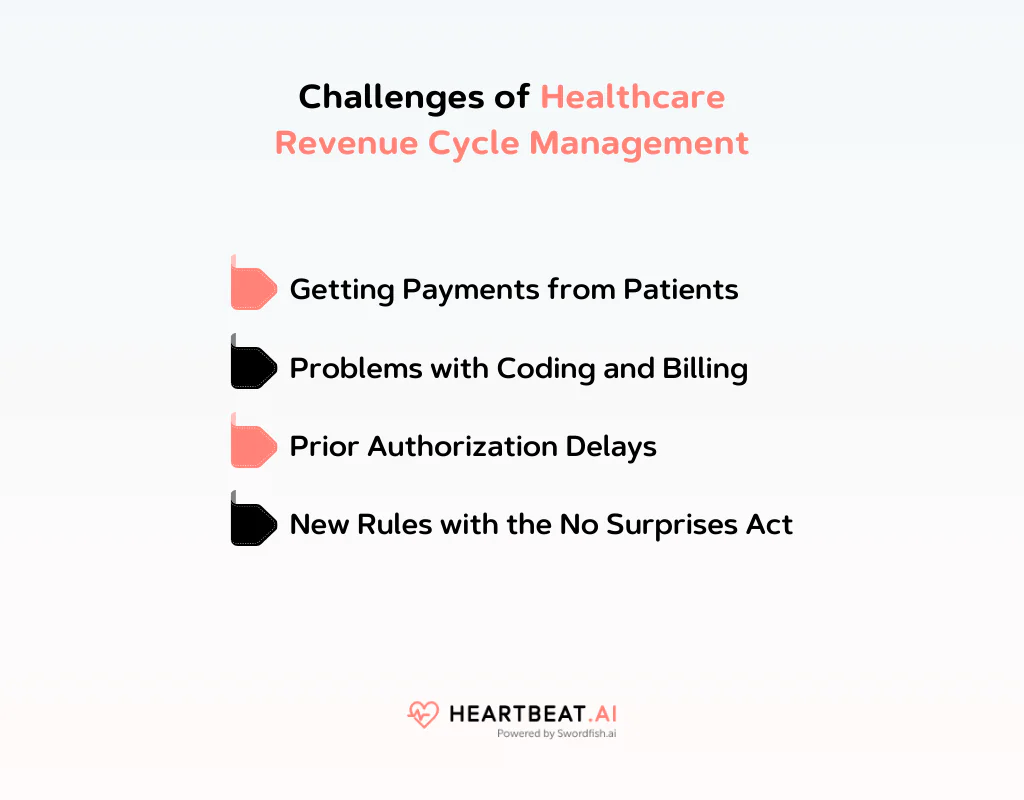
Getting Payments from Patients
A big issue is collecting money from patients either before or when they get treatment. A study by InstaMed in 2020 showed that 74% of healthcare providers waited over a month to get paid by patients.
Since many people struggle with high costs and tight budgets, healthcare places need to figure out how to get paid without causing patients stress. With the COVID-19 pandemic, healthcare providers have had to think creatively about collecting payments.
They’ve started offering more ways to pay, being flexible when they ask for payment, and sometimes allowing patients more time to pay.
Problems with Coding and Billing
Another problem is getting the billing codes right. If the codes are wrong, payments can be late or not come through at all.
To stop these errors, healthcare places are teaching their staff how to correctly use codes, write down everything properly, and know the financial rules.
Prior Authorization Delays
Waiting for approval before a treatment can start is another hurdle. This process can slow down treatment and complicate how payments are handled.
New Rules with the No Surprises Act
The No Surprises Act, which began in January 2022, aims to protect patients from unexpectedly high bills from out-of-network providers. Healthcare providers now have to change how they handle their billing to follow these new rules.
Effective Hospital Revenue Cycle Management Examples
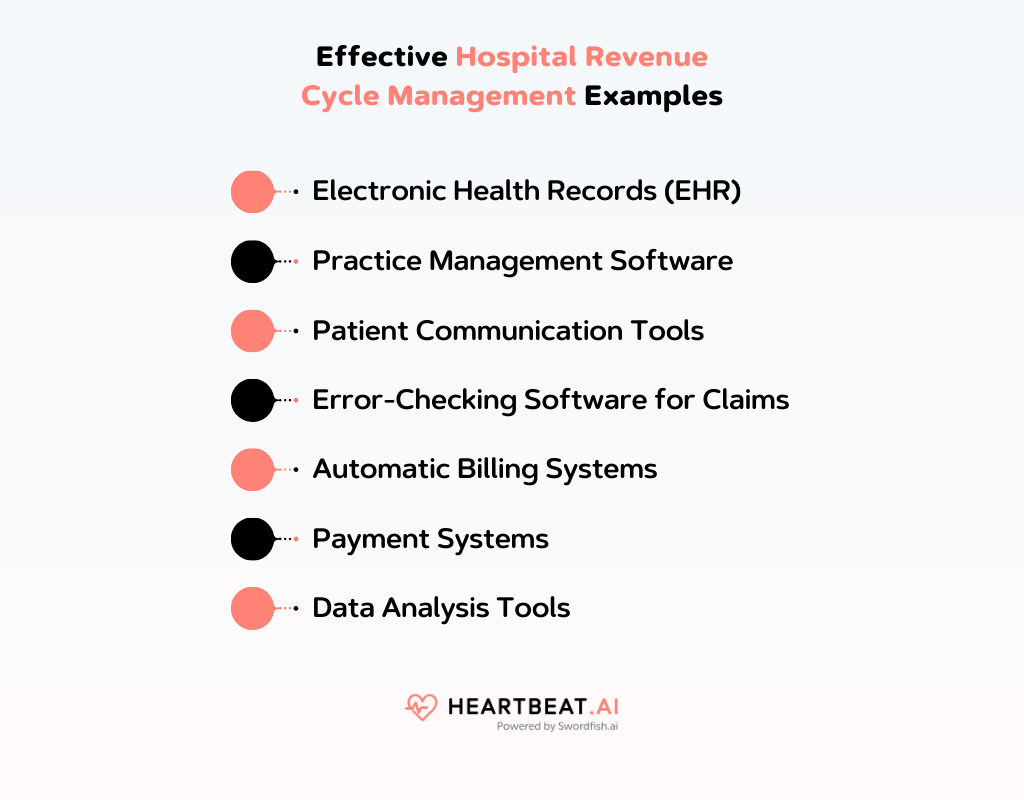
Hospitals use a lot of technology to manage their money. Here are some examples:
- Electronic Health Records (EHR): These are like digital health files for each patient.
- Practice Management Software: It helps run the hospital’s day-to-day tasks.
- Patient Communication Tools: These make it easier for patients to talk with the hospital.
- Error-Checking Software for Claims: It looks for mistakes in medical bills before they go to insurance companies.
- Automatic Billing Systems: These handle billing with less need for people to do the work.
- Payment Systems: They manage how the hospital gets and spends money.
- Data Analysis Tools: These help hospitals understand their financial situation better.
Find the Contact List of the Best Healthcare Revenue Cycle Management Consultant
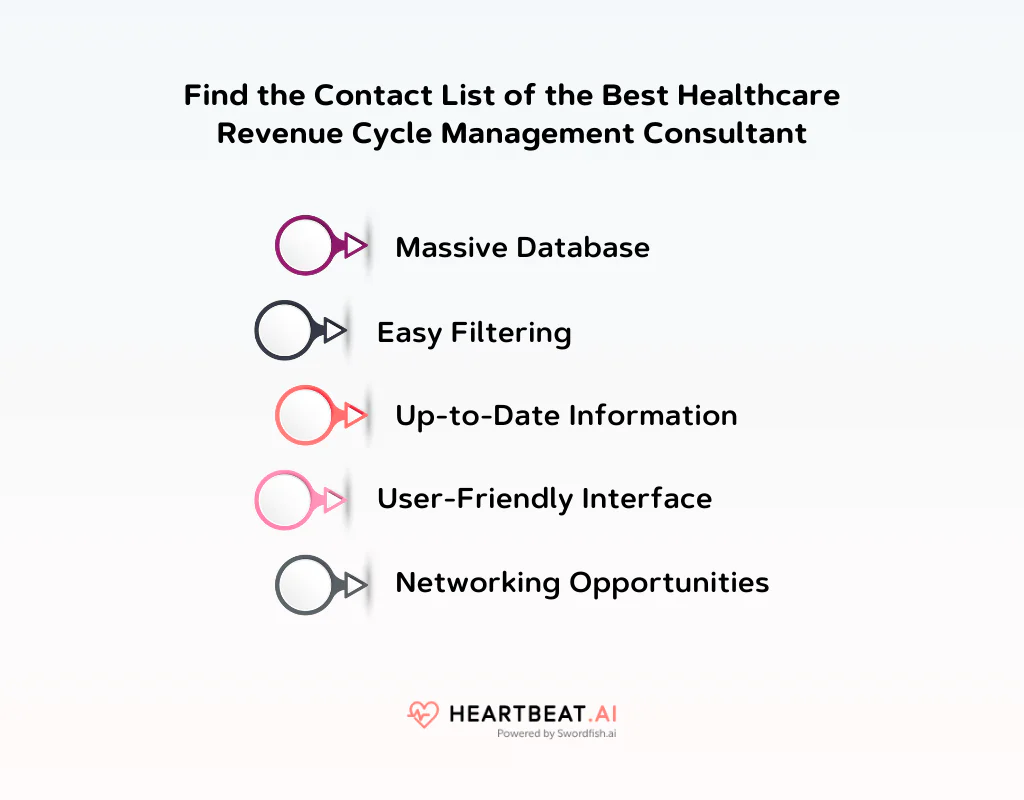
When looking for the best healthcare revenue cycle management consultant, Heartbeat is a key resource for healthcare workers and places. Here’s how Heartbeat AI helps in this important search:
Massive Database
Heartbeat AI opens the door to a huge database with over 11 million healthcare professionals in the USA. It includes a wide variety of healthcare revenue cycle management consultants.
Easy Filtering
Heartbeat lets you use special search tools to find exactly what you need. You can pick people based on their skills in managing hospital money, where they are, and how much experience they have. This ensures you find a consultant who matches your organization’s unique requirements.
Up-to-Date Information
The platform keeps its information current, offering the latest details on consultants’ skills, experience, and availability. This is crucial for making informed decisions in a rapidly changing healthcare environment.
User-Friendly Interface
Heartbeat AI is made to be easy to use, so no matter how much you know about technology, you can quickly find the consultant you need. It’s set up in a way that helps you smoothly search and connect with the right consultant without any hassle.
Networking Opportunities
With Heartbeat AI, building your professional circle is super simple. It gives you access to 8.8 million cell phone numbers with a high accuracy rate — 84% for phones and 92% for emails right off the bat.
There’s also a handy browser extension that lets you network on LinkedIn, Facebook, and all over the internet. This way, reaching out to a revenue cycle management (RCM) consultant is straightforward and effective.
Conclusion
In this guide we’ve covered the best ways of effective hospital revenue cycle management to improve how hospitals manage their money, especially the money coming in.
By streamlining the process for patient registration and ensuring accurate coding, hospitals can start to see improvements in their financial health. Handling claims more efficiently and making sure insurance companies pay as expected are key steps.
At Heartbeat AI, we understand the challenges faced by healthcare and offer a contact list of these professionals. By choosing us, healthcare providers get access to services that save money, the latest technology, and a team of experienced professionals.
Frequently Asked Questions
What is efficient revenue management?
Revenue management is really important in many industries because it’s key to making a profit. It’s all about making as much money as possible. This is done by setting the right prices and controlling how much they sell.
How do you measure the effectiveness of revenue management in hospitals?
To see if a hospital’s money management is good, a few things should be checked. Is the hospital making more money and not wasting it? Are the patients happy? Are most of the beds used? Is the billing correct? Looking at these helps you understand if the hospital is doing well with its money and services.
What is KPI in RCM?
Healthcare providers use key measures, known as KPIs, to check their financial health. These KPIs help them understand how they’re doing money-wise. By watching these indicators, they can find ways to make sure they’re earning as much as possible, keeping their finances in good shape.

